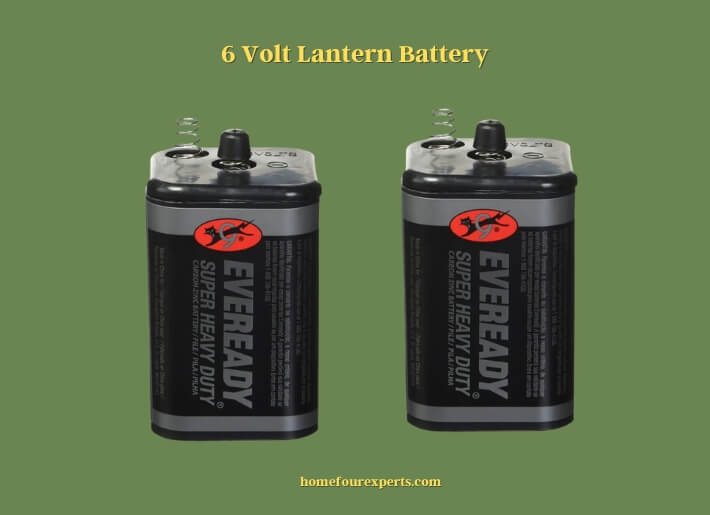Published on: June 11, 2022
Written by Liam Jaxon / Fact-checked by David Rowan
If you enjoy camping, you know the value of a lantern to use in power outages, indoors or out. Most modern lanterns are 6-volt lantern battery operated, and that is why it is vital to have adequate battery supplies. Taking extra batteries when going camping or on other trips is usually a brilliant idea. But it’s important to know whether or not the features and specifications of 6-volt lantern batteries can fulfill your camping demand. Here in the following writing, you will find the details, so keep reading.

Previously in another article, we briefly discussed the Top 12 Deep Cycle RV Batteries, which are the most important source of power supply at any outdoor activity. However, if you only need a power source for a lantern, a 6-volt battery outperforms normal torch batteries. It’s best to opt for a reliable 6-volt battery that quickly gives a large amount of power.
What Is a 6-volt Lantern Battery?
Torches and lanterns both use 6-volt lantern batteries, which are rectangular and often alkaline in composition. They are made up of numerous cells contained within a single housing, which causes them to be physically larger than ordinary batteries. Their bigger size enables them to provide more power than smaller torch batteries, such as AA, C, and D.
What Are the Uses of Lantern Batteries?
Most of the common questions I got is what are 6-volt lantern batteries used for? Significantly, torches and lanterns are frequently powered by batteries, which have a higher energy capacity and a sealed design that allows them to endure repeated usage. This is especially critical when torches or lanterns are being utilized under difficult or nominal working circumstances. Nominal capacity depends on various factors, including discharge current, discharge temperature, device cutoff voltage, etc.
Lantern Battery Volt Types
The following are the many types of lantern battery Volts:
4.5-volts
The terminals of the 4.5-volt lantern battery are made of metal strips. It is mainly employed to provide power to torches.
6-volts
A three-cell sealed lead-acid battery constructs the 6-volt rechargeable variety. Typical use in construction, work lights are powered by these batteries.
7-volts
The 7-volt type contains screw terminals and a rectangular base, while the 12-volt type does not. It is common practice to connect a carrying handle between the terminals to improve ease of use in situations where it is critical, such as in the construction industry.
12-volts
In addition to screw terminals and a rectangular base, the 12-volt version includes a rectangular base as well as screw terminals. When used in conjunction with an adaptor, it can be utilized to power vehicle accessories.
6-volt Lantern Batteries Specifications and Features
Lantern batteries are lead-acid batteries made up of four bigger cells, typically 1.5V D batteries joined together. Manufacturers claim 9-12 Ah capacity for 6-volt carbon-zinc alloy lantern batteries. Astringent Batteries for 6-volt lanterns normally have 12-18 Ah capacities, while certain low-current variants can have up to 26 Ah. Most heavy-duty alkaline batteries have 12 to 15 Ah capacity.
A 6-Volt battery contains the following features:
- 6-Volt Batteries have a larger capacity for energy storage;
- It has a thicker plate for sturdiness;
- They can be used for a longer period;
- Most 6V batteries are deep cycled to maximize storage and discharge capacity;
- Ideal for those on a budget;
- Allow charge and discharge for a longer time.
Types of 6-volt Lantern Batteries
The most common type of 6-volt lantern battery is the non-rechargeable variety; however, rechargeable 6-volt lantern batteries are also available.
In most cases, non-rechargeable 6-volt zinc-carbon or alkaline lantern batteries with spring connections are utilized in a lantern. But there are three types of 6-volt lantern batteries: spring-top terminals, screw-top terminals and rechargeable 6 V batteries.
Following are the details:
Spring-Top 6-Volt Lantern Batteries
Positive and negative terminals are located in the same corner of the spring-top 6-volt lantern batteries, making them ideal for use in lamps and other lighting applications. MN908 (alkaline), 4R25 (carbon-zinc), 908A (alkaline) et al. are standard labels for these batteries.
A few brands utilize their own labels, such as [amazon link=”B07RXVJ8JK” title=”Energizer Max 6V Lantern Battery” /]. Spring terminals are more typical for ordinary usage.
Screw-Top 6-Volt Lantern Batteries
Battery dimensions are 109.5 x 66.7 mm for screw-top 6-volt lantern batteries. The positive terminal is located at one of the corners of the battery, and the negative terminal is located in the middle.
There are also a variety of labels for these batteries, including 4LR25X (alkaline), 4R25X (carbon-zinc), and others. Some of the most common labels for these batteries are 915A (alkaline), 915 (carbon-zinc), and 915A (alkaline). Battery terminals with screw tops can be used in applications requiring a more secure connection between the battery and wires.
Rechargeable 6-Volt Lantern Batteries
Chargeable 6-volt lantern batteries are less common than non-rechargeable types and therefore are more expensive. But the only challenge of using the rechargeable battery is using the appropriate charger. Because it’s important to know whether you can use a 12v Charger for a 6v battery or not.
Batteries for rechargeable 6-volt lanterns can be made in a variety of chemistries, including the following:
Lead-acid Chemistry
Lead-acid batteries have three flat cells, each having a nominal voltage of 6 volts and 4-5 AH capacity.
Four NiCd F-Size Batteries
Battery holders explicitly designed for NiCd F-size batteries have nominal voltages of 4.88 and 6.6-7 Ah, respectively, which means they can handle large currents.
Four NiMH F-Size Batteries
Nominal voltage is 4.8 volts, with a capacity of 12-18 Ah, from four NiMH F-size batteries in a unique battery holder.
Our Recommendation of 6-volt Lantern Batteries
There is a variety of 6-volt Lantern Batteries available on the market. ” We’ve compiled a list of some well-known brands for your perusal.
| Models | Brands | Cell Composition | Shelf Life | Unit Count |
| [amazon link=”B07ZDQ92FX” title=”Energizer 6V Battery” /] | Energizer | Alkaline | 3 years | 1 count |
| [amazon link=”B0043CHX38″ title=”Eveready 6 Volt Lantern Battery” /] | Eveready | Zinc Carbon | 2 years | 1 count |
| [amazon link=”B004ANPOG8″ title=”Duracell CopperTop 6V battery” /] | Duracell | Alkaline | 5 years | 1 count |
| [amazon link=”B07MS6GZJG” title=”Neptune 6V battery” /] | Neptune | Sealed Lead Acid | ———— | 1 count |
| [amazon link=”B000BPCUV6″ title=”Interstate Batteries 6V battery” /] | Interstate | Zinc Carbon | 2 years | 1 count |
| [amazon link=”B0000AY89N” title=”RAYOVAC Heavy Duty Lantern Battery” /] | Rayovac | Zinc Carbon | 2 years | 1 count |
| [amazon link=”B00OAL06TA” title=”Mighty Max 6V Battery” /] | Mighty Max | Lead-Acid, AGM | 2 years | 1 count |
FAQs
Can Keeping Hazard Lights On Drain a 6-volt Lantern Battery?
Yes, keeping hazard lights on can significantly affect a 6-volt lantern battery. The constant draw of power from the hazard lights can drain the battery, causing it to lose its charge more quickly. It’s important to be mindful of the effect of hazard lights on battery life to avoid unexpected power loss.
Can a 6-volt Lantern Battery Be Recharged?
Yes, if the lantern is rechargeable, so is a 6-volt lantern battery. The batteries can be changed by rewiring the flashlight. With an old charger that can give around 250 ma when attached to the battery, the lantern can be fully recharged in around 20 hours.
Are E-Bike Batteries Similar to 6-volt Lantern Batteries in Terms of Longevity and Power?
When comparing e-bike batteries to 6-volt lantern batteries, it’s important to note that they are not similar in terms of longevity and power. Powerful ebike battery options are specifically designed to provide long-lasting and reliable power for electric bikes, whereas 6-volt lantern batteries may not have the same capacity or longevity.
How Do You Make a 6-volt Lantern Battery?
To create a 6-volt battery, connect:
- 2×3 volt Lithium button cells;
- Three 2-volt lead-acid cells in parallel;
- Four 1.5 volt alkaline or zinc-carbon cells in series;
- Five 1.2 volt NiFe, NiCd, or NiMH cells in series.
You are done with making a 6-volt battery. The cell voltages are nominal and are affected by the charge state and the voltage drop generated by the load current passing through the internal resistances.
Why Do 6v Batteries Outlast 12v?
6-volt batteries have thicker plates, allowing for more frequent charging and discharging. 6-volt batteries are lighter due to their fewer plates.
Do 9-volt Chargers Work on 6-volt Batteries?
To charge a 6 V battery with a 9 V charger, keeping the charging current within the battery’s safe operating range is the key here; when the battery is fully charged, limit and switch off the charging voltage.
How Long Does It Take to Charge a 6v Battery?
It takes 10 hours to charge 6v batteries fully and 6 hours to fully recharge 12v batteries. It takes 18 hours to charge 12v batteries fully and 12 hours to recharge them.
Final Verdict
I hope you now understand all about choosing the right 6-volt lantern battery for your next trip. These batteries are a need in our daily lives. If you want a non-rechargeable spring-top 6-volt lantern battery, check for respected brands that make them.
Carbon-zinc batteries are reasonably priced despite their short shelf life and lower capacity. Although alkaline batteries have a longer shelf life of up to five years, their higher price tag may be worth it if you just require a few of these cells. But remember, it’s important to properly dispose of old batteries when they are replaced with fresh ones.
Read more:
About This Writer

Hi, I am responsible for the 'Homeowners Power Solutions' category. My name is Liam Jaxon and a licensed technician with 7 years of experience in vehicle batteries, electrical gadgets, and home appliances. My working experience in different residential & light commercial electrical sectors and the automobile industry helped to acquire vast knowledge in this industry.